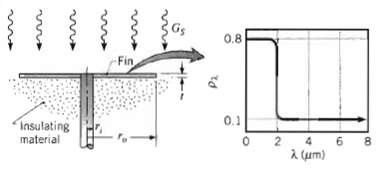An annular fin of thickness t is used as a radiator to dissipate heat for a space
Question:
An annular fin of thickness t is used as a radiator to dissipate heat for a space power system. The fin is insulated on the bottom and may be exposed to solar irradiation GS. The fin is coated with a diffuse, spectrally selective material whose spectral reflectivity is specified. Heat is conducted to the fin through a solid rod of radius ri, and the exposed upper surface of the fin radiates to free space, which is essentially at absolute zero temperature.
(a) If conduction through the rod maintains a fin base temperature of T(ri) = Tb = 400 K and the fin efficiency is 100%, what is the rate of heat dissipation for a fin of radius ro = 0.5 m? Consider two cases, one for which the radiator is exposed to the sun with GS = 1000 W/m2 and the other with no exposure (GS = 0).
(b) In practice, the fin efficiency will be less than 100% and its temperature will decrease with increasing radius. Beginning with an appropriate control volume, derive the differential equation that determines the steady-state, radial temperature distribution in the fin. Specify appropriate boundary conditions.

The word "distribution" has several meanings in the financial world, most of them pertaining to the payment of assets from a fund, account, or individual security to an investor or beneficiary. Retirement account distributions are among the most...
Step by Step Answer:

Fundamentals of Heat and Mass Transfer
ISBN: 978-0471457282
6th Edition
Authors: Incropera, Dewitt, Bergman, Lavine





